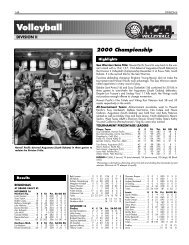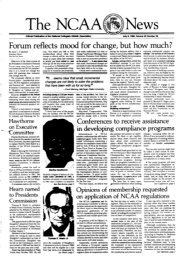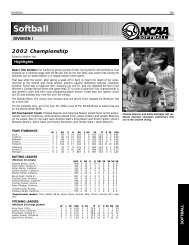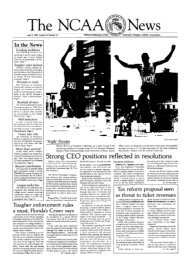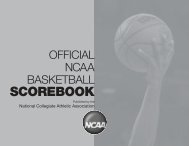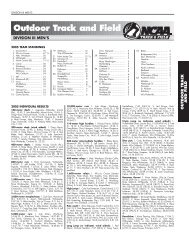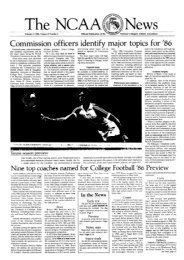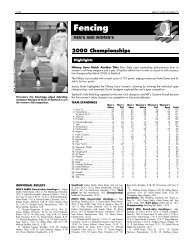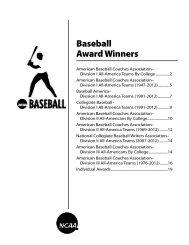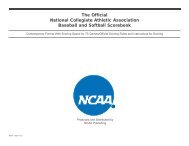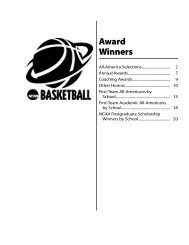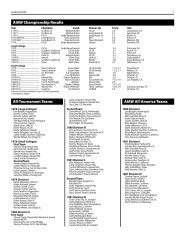Sports Medicine Handbook - NCAA
Sports Medicine Handbook - NCAA
Sports Medicine Handbook - NCAA
You also want an ePaper? Increase the reach of your titles
YUMPU automatically turns print PDFs into web optimized ePapers that Google loves.
96<br />
Eye Safety in <strong>Sports</strong><br />
January 1975 • Revised August 2001<br />
Eye injuries in sports are relatively<br />
frequent, sometimes catastrophic,<br />
and almost completely preventable<br />
with the use of appropriate<br />
protective devices. A sports eye<br />
protector may be a spectacle, a<br />
goggle, a face-supported protector,<br />
or a protector attached to a helmet.<br />
It comes with or without lenses, is<br />
capable of being held securely in<br />
place, and may protect the face as<br />
well as the eyes. Some forms can be<br />
worn over regular glasses. <strong>Sports</strong><br />
eye protectors are specially<br />
designed, fracture-resistant units that<br />
comply with the American Society<br />
for Testing and Materials (ASTM),<br />
or the National Operating<br />
Committee on Standards for<br />
Athletic Equipment (NOCSAE)<br />
standards for specific sports.<br />
Approximately one-third of all<br />
persons participating in sports<br />
require corrective lenses to achieve<br />
the visual acuity necessary for<br />
proper and safe execution of their<br />
particular sports activity. Athletes<br />
who need corrective eyewear for<br />
participation should use lenses and<br />
frames that meet the appropriate<br />
safety standards. At this time,<br />
polycarbonate plastic is the only<br />
clear lens material that has been<br />
tested for sports and is<br />
recommended for all sports with the<br />
potential for impact. Other impact-<br />
resistant lens materials may be<br />
available in the near future. Contact<br />
lenses are not capable of protecting<br />
the eye from direct blows. Student-<br />
GUIDELINE 3b<br />
athletes who wear contact lenses for<br />
corrective vision should wear<br />
appropriate sports safety eyewear<br />
for ocular protection.<br />
The American Academy of<br />
Opthalmology recommends that<br />
head, face and eye protection<br />
should be certified by either<br />
the Protective Eyewear Certifi-<br />
cation Council (PECC — www.<br />
protecteyes.org/), the Hockey<br />
Equipment Certification Council<br />
(HECC — www.hecc-hockey.org/),<br />
the National Operating Committee on<br />
Standards for Athletic Equipment<br />
(NOCSAE — www.<br />
nocsae.org/), or the Canadian<br />
Standards Association (CSA —<br />
www.csa-international.org/). The<br />
cited websites will have more<br />
specific information on these<br />
standards. Certification ensures that<br />
the protective device has been<br />
properly tested to current standards.<br />
Protective eyewear should be<br />
considered for all sports that have a<br />
projectile object (ball/stick) whose<br />
size and/or speed could potentially<br />
cause ocular damage. Eye<br />
protection is especially important<br />
for functionally one-eyed sports<br />
participants (whose best corrected<br />
vision in their weaker eye is 20/40<br />
or worse). Eye protection devices<br />
are designed to significantly reduce<br />
the risk of injury, but can never<br />
provide a guarantee against such<br />
injuries.<br />
Summary<br />
1. Appropriate for eye protection<br />
in sports:<br />
a. Safety sports eyewear that<br />
conforms to the requirements of<br />
the American Society for Testing<br />
and Materials (ASTM) Standard<br />
F803 for selected sports (racket<br />
sports, basketball, women’s<br />
lacrosse, and field hockey).<br />
b. <strong>Sports</strong> eyewear that is attached<br />
to a helmet or is designed for<br />
sports for which ASTM F803<br />
eyewear alone provides<br />
insufficient protection. Those for<br />
which there are standard<br />
specifications include: skiing<br />
(ASTM 659), and ice hockey<br />
(ASTM F513). Other protectors<br />
with NOCSAE standards are<br />
available for football and men’s<br />
lacrosse.<br />
2. Not appropriate for eye<br />
protection in sports:<br />
a. Streetwear (fashion) spectacles<br />
that conform to the requirements<br />
of American National Standards<br />
Institute (ANSI) Standard Z80.3.<br />
b. Safety eyewear that conforms to<br />
the requirements of ANSI Z87.1,<br />
mandated by OSHA for industrial<br />
and educational safety eyewear.



